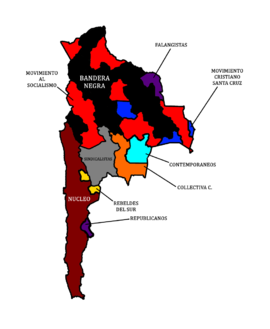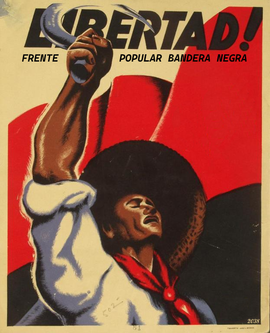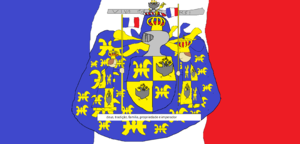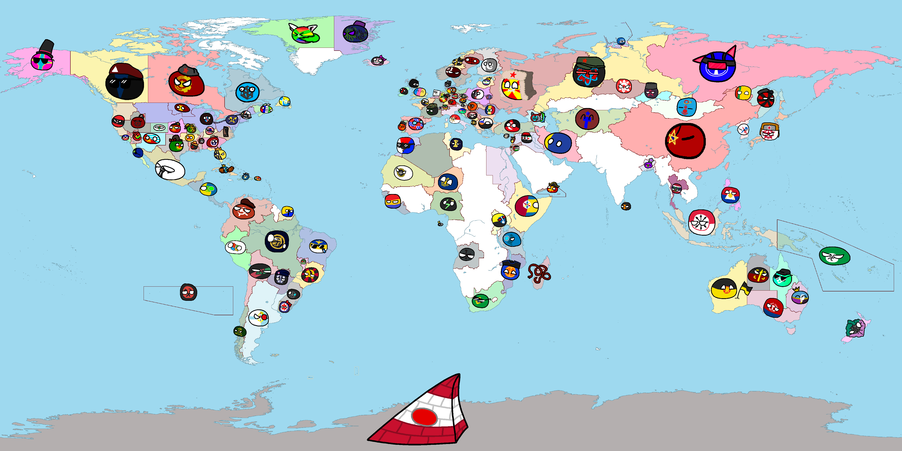Map
Countries
File:LexAcce.png South Brazil File:PCBallerSouthBrazil.png
For more info see: PCBaller World/South Brazil (Work in Progress)
The region to once comprise the southern region of Brazil, simply refered to as "South Brazil" is a territory without any central state or sovereign power but a melting pot of different factions, cultures and identities fighting to gain dominance over the other, the Southern Brazilian Territory is merely the place where most of these groups overlap.
Factions
Noteworthy factions within the region.
- File:Techchurch.png Church of The Machine
 Transhumanism
Transhumanism Accelerationism
Accelerationism Culturally Left (Usually)
Culturally Left (Usually) Eugenicism (Alledged)
Eugenicism (Alledged) Cultism (Accused)
Cultism (Accused)
Congratulations! You found the secret faction, don't talk to anyone about this.
- File:LexAcce.png "Marble Race Klub"
Outside Factions
Noteworthy factions outside the region.
Internal Relations
What each faction thinks of the other factions
- Allies
- Friendly
- File:AtlasConfederateIcon.png Atlas Confederacy &
 Any other capitalist communities - There are many private cities, covenant communities and other such places in South Brazil, the Confederacy regognises the autonomy of all of them.
Any other capitalist communities - There are many private cities, covenant communities and other such places in South Brazil, the Confederacy regognises the autonomy of all of them.
- File:AtlasConfederateIcon.png Atlas Confederacy &
- Positive
- File:Techchurch.png Church of the Machine & File:AtlasConfederateIcon.pngAlmost EveryoneFile:LPC.png - The Church has many temples and followers all over South Brazil, the Confederacy and Coalition are not agaisnt their presence (except for
 some in the Coalition) and the churches usually (
some in the Coalition) and the churches usually ( but not always) shares their technology with the surrounding communities (either
but not always) shares their technology with the surrounding communities (either  free or
free or  paid).
paid).
- File:Techchurch.png Church of the Machine & File:AtlasConfederateIcon.pngAlmost EveryoneFile:LPC.png - The Church has many temples and followers all over South Brazil, the Confederacy and Coalition are not agaisnt their presence (except for
- Mixed
- Negative
 Neo-Integralist Aktion & File:AtlasConfederateIcon.png Atlas Confederacy - Both groups have strong animosity against each other but have decided not to be overtly hostile, leaving each other alone.
Neo-Integralist Aktion & File:AtlasConfederateIcon.png Atlas Confederacy - Both groups have strong animosity against each other but have decided not to be overtly hostile, leaving each other alone.
- Enemy
- File:AtlasConfederateIcon.png Atlas Confederacy & File:LPC.png Liberated People's Coalition - Both sides are very hostile and have escalated to violence at several points, the Confederacy sees the LPC as a communist threat to liberty and the free-market while the Coalition sees the ACG as capitalist reactionaries that wish to subjugate them.
- At War
- File:LPC.png Liberated People's Coalition &
 Neo-Integralist Aktion - Both factions are currently fighting although as of late no progress was made by either side and the war sits at a standstill.
Neo-Integralist Aktion - Both factions are currently fighting although as of late no progress was made by either side and the war sits at a standstill.
- File:LPC.png Liberated People's Coalition &
Relations
What each faction thinks of other nations
- Allies
- Friendly
- Positive
- Mixed
- Negative
- File:Techchurch.png Church of The Machine & File:TechchurchPB.png Perfectionist Church of The Machine - The Church has shunned and exiled many members of the so called "Perfectionist Church of The Machine" for their mysanthropic and unethical behaviour.
- Enemy
- At War
- File:Techchurch.png Church of The Machine &
 Church of the Old Ones (Atlantic) - The Church of The Machine is raging a crusade against the Atlantic Church of the Great Old Ones and they have sucessufully driven them off of South Brazil.
Church of the Old Ones (Atlantic) - The Church of The Machine is raging a crusade against the Atlantic Church of the Great Old Ones and they have sucessufully driven them off of South Brazil.
- File:Techchurch.png Church of The Machine &
File:Cball-SocBrazil.png Southeast Brazil
The Brazilian Commune that controls the southeast region of Brazil is governed by a dictatorship of the proletariat that has the goal of achieving socialism internationally.
Parties
 Ação Comunista Revolucionária (ACR) (Revolutionary Communist Action)
Ação Comunista Revolucionária (ACR) (Revolutionary Communist Action) Partido Comunista Brasileiro (PCB) (Brazilian Communist Party)
Partido Comunista Brasileiro (PCB) (Brazilian Communist Party) Unidade Popular (UP) (People's Unit)
Unidade Popular (UP) (People's Unit) Partido Socialista dos Trabalhadores Unificado (PSTU) (Workers' Unified Socialist Party)
Partido Socialista dos Trabalhadores Unificado (PSTU) (Workers' Unified Socialist Party)
Banned Groups
Parliament
 Outasia
Outasia
For more info see: PCBaller World/Outasia (Work in Progress)
![]() Federative Republic of Outasia
Federative Republic of Outasia
- Motto: Union and Democracy for our homeland!!
- Anthem: Liberdade! Liberdade!
- Capital: Recife
- Demonym: Outasian
- Language: Portuguese (official language), Spanish, English, German and 15 others
- Government Type: Semi-Parliamentary Republic
- President:
 Aquiles Paraizo (
Aquiles Paraizo ( PSDB)
PSDB) - Prime-Minister:
 Augusto Kimich (
Augusto Kimich ( PDU)
PDU) - Minister of Financy:
 Sérgio Mourin (
Sérgio Mourin ( PSDB)
PSDB) - Minister of Defense:
 Renan Silva Neto (
Renan Silva Neto ( PR)
PR) - Population: 66,482,855
- HDI: 0.932
- Code: OU
Outasia is a nation located in northeastern Brazil. Its capital is Recife and has a population of 66 million inhabitants. It is a ![]() liberal democracy composed of a
liberal democracy composed of a ![]()
![]() semi-parliamentary system.
semi-parliamentary system.
Outasia maintains the incredible social model, based on the ![]() Aquilenian model, with universal health care, subsidized higher education and a comprehensive social security scheme. These policies carried out by the toucan government ended up resulting in a great socioeconomic and developmental advance and a purchasing power of 153,232 dollars. The poverty rate in Outasia is around 0.004% in 2023.
Aquilenian model, with universal health care, subsidized higher education and a comprehensive social security scheme. These policies carried out by the toucan government ended up resulting in a great socioeconomic and developmental advance and a purchasing power of 153,232 dollars. The poverty rate in Outasia is around 0.004% in 2023.
Parties
 Partido Social Democrata Brasileiro (Brazilian Social Democratic Party)
Partido Social Democrata Brasileiro (Brazilian Social Democratic Party) Partido Democrático Unido (United Democratic Party)
Partido Democrático Unido (United Democratic Party) Partido Trabalhista Brasileiro (Brazilian Labor Party)
Partido Trabalhista Brasileiro (Brazilian Labor Party) Liberais (Liberals)
Liberais (Liberals) Partido Republicano (Republican Party)
Partido Republicano (Republican Party) Patriotas (Patriots)
Patriotas (Patriots) Partido Verde (Green Party)
Partido Verde (Green Party) Partido Comunista Outasiano (Outasian Communist Party)
Partido Comunista Outasiano (Outasian Communist Party) Cidadãos! (Citizens!)
Cidadãos! (Citizens!) Partido da Democracia Cristã (Christian Democracy Party)
Partido da Democracia Cristã (Christian Democracy Party)
Banned Groups
These are parties and organizations that have been permanently banned by the Outasian Court of Justice. These organizations are described by the government as terrorists and a threat to liberal democracy.
 Partido Comunista Revolucionário (Revolutionary Communist Party)
Partido Comunista Revolucionário (Revolutionary Communist Party) Movimento de Esquerda Revolucionário (Revolutionary Left Movement)
Movimento de Esquerda Revolucionário (Revolutionary Left Movement) Partido da Nova Ordem Nacional (New National Order Party)
Partido da Nova Ordem Nacional (New National Order Party) Frente Patriótica (Patriotic Front)
Frente Patriótica (Patriotic Front)
Parliament
The Outásia Parliament is unicameral, with only the House of Representatives as the only legislature in the country. By parliament, the 515 parliamentarians are elected, where they are chosen by the population democratically using the d'Hondt method.
Government (343/515)
 Brazilian Social Democratic Party (140/515)
Brazilian Social Democratic Party (140/515) United Democratic Party (106/515)
United Democratic Party (106/515) Liberals (32/515)
Liberals (32/515) Republican Party (44/515)
Republican Party (44/515) Citizens! (21/515)
Citizens! (21/515)
Independent (29/515)
 Patriots (19/515)
Patriots (19/515) Christian Democracy Party (10/515)
Christian Democracy Party (10/515)
Oposition (143/515)
 Brazilian Labor Party (100/515)
Brazilian Labor Party (100/515) Green Party (33/515)
Green Party (33/515) Outasian Communist Party (10/515)
Outasian Communist Party (10/515)
Relations
- Alliance:
 Global Treaty Organization (GTO)
Global Treaty Organization (GTO) - Economic-Orgs:
 Bloc of Free Trade
Bloc of Free Trade - Political-Orgs:
 Alternative United Nations (AltUN)
Alternative United Nations (AltUN)
Outasia is a member of the ![]() GTO, a military alliance of
GTO, a military alliance of ![]() liberal democracies.
liberal democracies.
Foreign Relations
 Poland - Outasia considers Poland to be a dictatorial and extremist
Poland - Outasia considers Poland to be a dictatorial and extremist  Russophile regime, as well as a threat to the
Russophile regime, as well as a threat to the  world's democracies and the
world's democracies and the  GTO.
GTO.- File:Cball-SocBrazil.png Brazilian Commune - Since its founding, Outásia's relations with the Brazilian Commune have been frozen. The Outasian government, through a law, opened the borders for all Brazilian immigrants who could flee the Brazilian Commune, at the same time installed a series of soldiers in case there was a Brazilian invasion in Outasia.
File:CPGC.png Gran Colombia 
People's Union of Gran Colombia
”Union Popular de la Gran Colombia"
- Anthem: "El Pueblo Unido"
- Capital: Bogotá
- Demonym: Colombian
- Languages: Spanish, Portuguese, Quechua, Aymara, Wayuu, Guaraní, and other indigenous languages
- Dominant Religion: Catholicism, Indigenous and Afro-Caribbean religions, Islam
- Government: Participatory Democracy under a Federal Marxist-Leninist Republic
- Population: 98,543,896
Gran Colombia, officially known as The People's Union of Gran Colombia is a federation of socialist republics that takes up most of northern South America. It is composed of 3 socialist republics and 3 autonomous republics: The Socialist Republic of Colombia, the Socialist Republic of Venezuela, the Socialist Republic of Ecuador, the Wayuu Autonomous Republic, the Afro-Descendant Autonomous Republic, and the Magdalena River Delta Autonomous Republic.
The history of Gran Colombia can be traced to the democratic election of president Ricardo Rafael Morales, a strongman nationalist leader who nationalized various industries to protect indigenous Colombians. A dozen cadets and soldiers, all youths, traveled to Boyacá to commemorate Simón Bolivar's victory at the Battle of Boyacá, where they were personally greeted by President Morales. Among these cadets were many of the future heroes of the June Revolution, which includes Efraín Rojas Molina, Gran Colombia's future founding father.
Morales later nationalized the mining and extractive industry which was the final straw for the USA. Shortly after, he lost power in a military coup that was backed by the CIA. A second wave of right-wing military dictatorships began popping up all over Latin America, and this led to a period of mass political and social unrest. This intensification of class struggle and mass repression led to the formation of various revolutionary groups across the region. Intense negotiations and alliances take place, culminating in the formation of a united front, the Gran Colombian Revolutionary Front (GCRF).
The GCRF gains significant traction among the masses, successfully mobilizing workers, peasants, and intellectuals under the common goal of overthrowing the capitalist system. The Front advocates for an end to imperialist dominance and the establishment of a socialist society that prioritizes social welfare, economic equality, and collective ownership of resources. A protracted people's war ensues, with the GCRF guerrilla fighters engaging in guerrilla warfare tactics against the well-equipped military forces of the ruling regimes. The revolutionaries capture key territories, gradually weakening the governments' hold on power. The movement gains international support from other socialist countries and anti-imperialist movements, further bolstering their cause.
After years of intense struggle and sacrifice, the GCRF successfully topples the oppressive regimes in each of the participating countries. In the aftermath, the revolutionary leaders convene to form a new political entity, the People's Union of Gran Colombia. Led by Efraín Rojas Molina, they forge a vision for a society based on socialist principles, guided by the ideologies of Marxism-Leninism and collective decision-making. The Union becomes a beacon of hope for anti-imperialist struggle, inspiring revolutionary across the planet.
 Andean Communes
Andean Communes
Association of Autonomous Communes in the Andes
”Asociación de Comunas Autónomas de los Andes”
- Motto: "Land and liberty!" ("Tierra y libertad!")
- Anthem: "Hijos del Pueblo" (unofficial)
- Capital: La Paz (unofficial)
- Demonym: Andean
- Languages: Spanish, Aymara, Quechua, Chiquitano, Guaraní, Mapuche, other indigenous languages
- Dominant Religion: Atheism, Catholicism, various indigenous beliefs
- Government: None (synthesis anarchist association)
- Population: 15.9M
The Association of Autonomous Communes in the Andes (Asociación de Comunas Autónomas de los Andes), often referred to as the United Andean Communes, Andes International Community (Comunidad Mundial Andina) or C.M.A., is a collection of autonomous but cooperative anarchist communes in what used to be Bolivia and northern Chile, and the result of the violent Andean Revolution of 2036, a primarily anarchist rebellion against the authoritarian dictatorial governments of Bolivia and Chile: the military juntas of Gustavo Sejas Revollo (in Bolivia) and José Antonio Kast (in Chile) that took power in 2030 and 2027 respectively.

The C.M.A. was officialy formed in late 2041 with the end of the five-year Andean Revolution, in an agreement between the major forces that participated in it, namely the Bolivian Black Flag Organization (Organización Bandera Negra Boliviana), Core of Direct Action in Chile (Núcleo de Acción Directa en Chile), Libertarian Syndicalist Movement (Movimiento Sindicalista Libertario) and Libertarian Revolutionary Caucus (Camarilla Revolucionaria Libertaria, the majority group in the "Movement for Socialism" party after its 2033 libertarian shift), as well as other smaller groups. Although a spectacular victory, the Revolution did not secure the liberation of southern Chile and Patagonia, as it originally intended to do, with the C.M.A locked in a desperate ceasefire with the authoritarian southern Chilean government of José Antonio Kast. Anarchist forces both in the metropolitan region of Santiago and in largely ungoverned Chilean Patagonia however, have started to popularize the idea of a second revolt to finalize the liberation of Chile and Bolivia.
While still in its early stages of development, the C.M.A. has so far managed to sustain itself in the aftermath of the Revolution. It follows bottom-up and horizontal organization, and acts as a free association of local communes that, in turn, cooperate to allow cities and regions to function. Property and the means of production are commonly held, and most communes follow a library or gift economy, as was originally intended by the majority of organizations that participated in the Revolution, with a few instead opting for mutualism or other anarcho-individualist forms of economics. Aside from local citizen meetings, the Community Development Assembly (Asamblea de Desarrollo Comunitario) takes place once a month, where multiple randomly selected citizens from each region discuss the future plans of the entire C.M.A., which they then vote on and pursue in their respective communities.
Some small areas officially under hegemony of the C.M.A. remain in open defiance of the Revolution's principles, and are generally shunned by the rest of the association, perhaps the most notable being the Christian Movement of Santa Cruz (Movimiento Cristiano de Santa Cruz), led by former CDP politician Luis Fernando Camacho, that has taken hold of the city of Montero and its surrounding area.
Many communist and socialist groups that aided the anarchists in the revolution have also in many instances criticised the C.M.A., considering it too weak to repel against a counter-revolutionary invasion, but have not acted directly against it. Remnants of the CIA-backed authoritarian government that was overthrown in the Revolution are also common in certain places, but not powerful enough to take a stand.
Recently, the C.M.A. Community Development Assembly, with initiative of the Pan-American Solidarity Movement, has joined the Alternative United Nations and made contact with the Eighth Workers' Internationale in an effort to spread the anarchist and socialist ideal throughout the world and help aid revolutionary movements in oppressive nations.
Major Factions

Revolutionaries
 Community Development Assembly
Community Development Assembly
 Andean Communist Forum
Andean Communist Forum
 Pan-American Solidarity Movement
Pan-American Solidarity Movement Indigenous Liberation Front
Indigenous Liberation Front
Counter-Revolutionaries
 Christian Movement of Santa Cruz
Christian Movement of Santa Cruz Anti-Communist Brigades
Anti-Communist Brigades
 National Republican Party (Chilean government remnants)
National Republican Party (Chilean government remnants) Bolivian Christian People's Falange (Bolivian government remnants)
Bolivian Christian People's Falange (Bolivian government remnants)
Other
 Latin American Red Cross
Latin American Red Cross National Conservation Pact
National Conservation Pact Anti-Industrial Farmers' Coalition
Anti-Industrial Farmers' Coalition Southern Chilean Liberation Mission in the Andes
Southern Chilean Liberation Mission in the Andes Free Information League
Free Information League
Demographics
| Ethnicity | % |
|---|---|
| 73.24% | |
| 16.43% | |
| 6.13% | |
| 5.19% |
Relations
- Allies
- Friendly
- Positive
- File:Cball-SocBrazil.png Brazilian Commune - Although we differ in civic matters, we stand with the Brazilian Commune in its path toward socialism.
- Mixed
- Negative
- Enemy
- At War
- The C.M.A. is not officially at war with any collective authority.
 Chile
Chile
For more info see: PCBaller World/Libertarian Kingdom of Chile
Parties
There is no political parties on Chile because Chile is a Monarchist country
Banned Groups
Parliament
There is no parliament on Chile because Chile is a Monarchist country
 Argentina
Argentina
Parties
Banned Groups
Parliament
 Antarctica
Antarctica
Parties
Banned Groups
Parliament
 Chilean Gov. in Exile
Chilean Gov. in Exile
Parties
Banned Groups
Parliament
 The Empire of Rodas
The Empire of Rodas
For more info see: PCBaller World Mirror/Rodas (Work in Progress)


The Empire of Rodas is a traditional and feudal monarchy led by Carlos I located in South America whose official religion is Catholicism. The history of the empire begins in 2025 when the instability caused by the Brazilian civil war between the Bolsonarists and the Lulists caused the independence of certain parts of the country that saw the golden opportunity they had to be independent and then the republic of the Amazon was created, it was democratic until a guy called Rodinha Pneus de Rodas whose party was and is to this day the reactionary party and he carried out a ''counter-revolution'' by carrying out a coup d'état in the capital, which is and was Manaus, with the support of the people and the context was that the republic of Amazonia was going through an economic crisis caused by an incompetent left-wing government and the people were wanting a solution that was not possible to be made by the old government, then a civil war broke out between the thousands of indigenous tribes, the old government, the reactionaries, the communists and the pacification forces of the alternative united nations and the democrats, the reactionaries won the civil war and rodinha pneus de rodas took over the government initially the country was still a republic but after all the measures and laws desired by the emperor had been made he restored the monarchy and renamed the country's name to ''Rodas'' one of his surnames
Parties
 Partido Reacionário (Reactionary Party)
Partido Reacionário (Reactionary Party) Partido Conservador (Conservative Party)
Partido Conservador (Conservative Party) Partido Democrata Cristão (Christian Democratic Party)
Partido Democrata Cristão (Christian Democratic Party) Partido Verde (Green Party)
Partido Verde (Green Party)
 Partido Nacionalista (Nationalist Party)
Partido Nacionalista (Nationalist Party) Partido Indígena (Indigenous Party)
Partido Indígena (Indigenous Party) Partido Venezuelano (Venezuelan Party)
Partido Venezuelano (Venezuelan Party)
Banned Groups
all communist, anarchist, socialist, social-democratic, progressive, centrist [except Christian democrats], liberal, capitalist, fascist and ultranationalist parties and associations and groups are banned
Parliament
the parliament is called ''imperial assembly'' and is made up of three chambers the people's chamber the chamber of nobles and the chamber of clerics the chamber of the people has 1000 representatives and the chamber of nobles has all The Nobles of Rodas and the The clergy chamber has almost all the clergy of Rodas except the cloistered clergy and all members of the People's Chamber are elected by the people by the method of proportional representation. Members of the chamber of nobles are members for life and when they die the heir takes the place of the deceased member if the noble has been removed from the chamber of nobles for having committed some crime and is therefore no longer noble, or the heir assumes the title or the chair is removed and ceases to exist, as for the chamber of clerics, when clerics are ordained they either become monks or friars or nuns or go to religious life in convents without having the obligation to remain cloistered or go to help the priests and celebrants are given a seat in the clergy chamber and this is only removed after death or dismissal by church authorities
Chamber of Clerics
 Catholic Clergy (3898/3898)
Catholic Clergy (3898/3898)
Chamber of Nobles
 Reactionary Party (2000/3020)
Reactionary Party (2000/3020) Conservative Party (677/3020)
Conservative Party (677/3020) Christian Democratic Party (278/3020)
Christian Democratic Party (278/3020) Green Party (50/3020)
Green Party (50/3020)
 Nationalist Party (5/3020)
Nationalist Party (5/3020) Indigenous Party (8/3020)
Indigenous Party (8/3020) Venezuelan Party (2/3020)
Venezuelan Party (2/3020)
chamber of the people
 Reactionary Party (589/1000)
Reactionary Party (589/1000) Conservative Party (200/1000)
Conservative Party (200/1000) Christian Democratic Party (100/1000)
Christian Democratic Party (100/1000) Green Party (50/1000)
Green Party (50/1000)
 Nationalist Party (34/1000)
Nationalist Party (34/1000) Indigenous Party (20/1000)
Indigenous Party (20/1000) Venezuelan Party (7/1000)
Venezuelan Party (7/1000)
 Free Libertarian Republic of Guiana and Suriname
Free Libertarian Republic of Guiana and Suriname
}}
Parliament
 Mato Grosso
Mato Grosso
Parties
Banned Groups
Parliament
 Uruguayan Confederation of Free Cities (UCFC)
Uruguayan Confederation of Free Cities (UCFC)
- Capital: Montevideo
- Demonym: Uruguayan
- Official Languages: Spanish, Italian
- Government: Shareholder Timocracy under a Confederal Alliance
- Population: ~6 Million
Parties
The UCFC does not have political parties in the traditional sense, as its corporate government structure has prevented their rise. There are many extraparliamentary political groups, but they're not very relevant so the government doesn't even bother keeping track of them.
Banned Groups
None.
Confederal Board of Directors
Uruguay, officially known as the Uruguayan Confederation of Free Cities (UCFC for short) is a confederation of various formalist city-states, ruled by timocratically elected for-profit corporate governments elected by citizen-shareholders. It has a population of about 6 million, up from about 3 million prior to the establishment of the current government, due to a growing birth rate and migration from europe due to the political upheaval in the continent. It's highly developed first world country, albeit quite rural and spread out. Industry is mostly small scale and spread out, as advances in 3D printing technologies spearheaded by several companies in the field have caused a resurgence in home manufacturing and cottage industry, as light industry companies take advantage of the omnipresence of 3D printers in people's homes to outsource production to them instead of investing in the construction of manufacturing plants. It's a fairly socially conservative country, but there's little state enforcement of it, as people have the right to free association, which allows them to keep any "undesirables" out of their communities. Regulation of the economy is minimal and the monetary policy is free banking. Uruguay is mostly non-aligned and anti-interventionist, though it allows small volunteer expeditions in foreign ideological enemy territory.
 Democratic Republic of Parauay
Democratic Republic of Parauay

